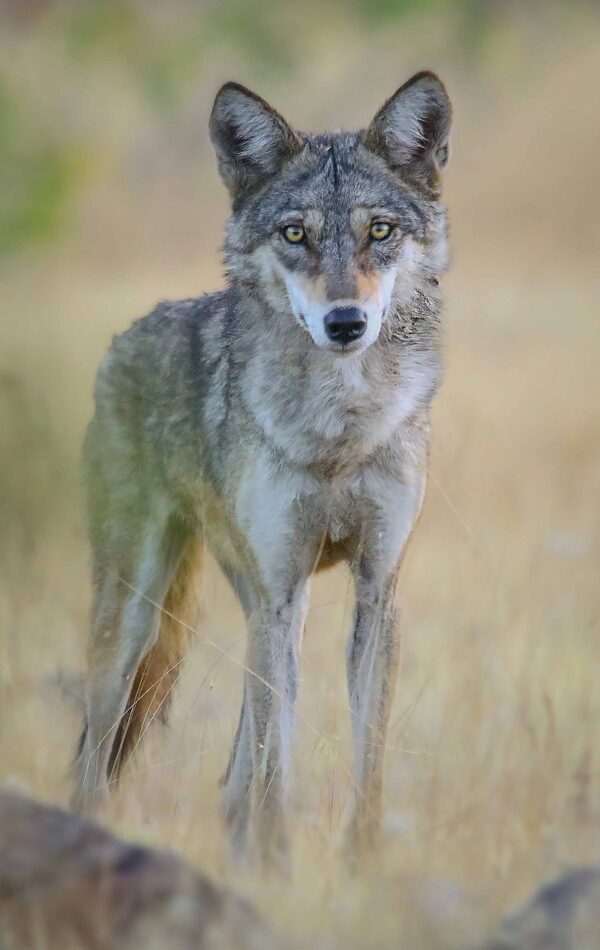The Indian grey wolf (Cannis lupus pallipes), a subspecies of the grey wolf, is a critically endangered species found primarily in the Indian subcontinent. These wolves once roamed freely across the vast grasslands and forests of the region, but today, they face numerous threats that are pushing them to the brink of extinction.
The Indian wolf could be far more endangered than previously recognized, according to a study from the University of California, Davis, and the scientists who sequenced the Indian wolf’s genome for the first time.
The findings, published in the journal Molecular Ecology, reveal the Indian wolf to be one of the world’s most endangered and evolutionarily distinct gray wolf populations. The study indicates that Indian wolves could represent the most ancient surviving lineage of wolves.
The Indian wolf is restricted to lowland India and Pakistan, where its grassland habitat is threatened primarily by human encroachment and land conversion.
“Wolves are one of the last remaining large carnivores in Pakistan, and many of India’s large carnivores are endangered,” said lead author Lauren Hennelly, a doctoral student with the UC Davis School of Veterinary Medicine’s Mammalian Ecology Conservation Unit. “I hope that knowing they are so unique and found only there will inspire local people and scientists to learn more about conserving these wolves and grassland habitats.”

Habitat loss
Indian wolves can be found in agro-pastoral areas that are not beyond the boundaries of protected forests. According to a WII report, there are no conservation efforts being made in India to rescue these wolves. Large amounts of biodiverse grasslands have been destroyed in India as a result of the country’s growing industrialization and urbanization. As a result, they frequently end up dead when they are compelled to live close to populated areas for food and shelter.
Researchers from the Zoological Survey of India (ZSI) recently conducted a study in an effort to better understand the causes of the rise in conflicts. In the research area, there was a network of 42 protected areas, including 36 wildlife sanctuaries and 6 national parks. Between 2015 and 2016, they located wolves at 126 different locations. This data was then used to train a computer programme to identify settings with specific traits that are essential to a species’ survival.
Dr. Lalit Kumar Sharma of ZSI said that “in order to confirm the model’s accuracy, we also went to the places. The software model determined that only 1,332 square kilometers of the 14,500 square kilometers of the total research area covered by the protected areas network were appropriate. In the study landscape, just five of the 42 protected locations were suitable for wolves.”
Habitat Fragmentation
The habitats of the Indian grey wolf is becoming isolated. This is due to the expansion of human settlements, deforestation and cropland expansion. As a result, numerous issues arise as a result of this, including interbreeding with stray dogs. Furthermore, habitat fragementation by linear infrastructure, increases the risk of roadkill.
Diseases
Indian grey wolves are declining due to interbreeding with feral dogs. As a result of hybridization, wolves loose can lead genetic diversity. Unfortunately, hybridization can also lead to the spread of diseases like canine distemper, canine parvovirus and rabies from domestic dogs to wolves. Moreover, the genetic variety that results from this hybridization may be lost, and the progeny may be less able to adapt to shifting environmental conditions.
How is climate change impacting the Indian Grey Wolf?
The distribution, and availability of prey have a massive impact on a wolf’s capacity to survive. This is how climate change is affecting the Indian grey wolf. The availability of water for wolves and their prey, for instance, can be impacted by the melting of glaciers in the Himalayas. In fact, the Himalayan wolves are heavily threatend by climate change.
Human Wolf Conflict
Conflict with people poses a serious threat to Indian grey wolves. As their food supplies are being limited and their habitats are being destroyed more regularly, these wolves are being driven to infiltrate human communities in quest of sustenance. Indian wolves prey livestock when there is a lack of available natural prey. Goats are their primary target among livestock small mammals, including sheep. Morover, tn unprotected grasslands, there the wolf range often overlaps with livestock graszing patterns
This frequently leads to clashes with humans. In retaliation, people frequently kill wolves, severely diminishing their population. Unfortunately, human wolf conflict is the primary reason the species is not being reintroduced to the United Kingdom. In fact, human wolf conflict has made the successful Yellowstone reintroduction controversial.
Lack of awareness about India’s Grey Wolf
In India, many individuals are unaware of the need to safeguard wildlife. For this reason, educating local residents about the importance of this species can prove fruitfal. This might inspire people to take action to protect wolves and their habitats. In addition, government agencies and environmental organisations may work together to implement regulations. This may decrease the impact of climate change on this species, such as repairing destroyed habitats and preserving important migration routes.
Conclusion
The Indian grey wolf is an endangered species that faces numerous threats. However, it is feasible to guarantee this species’ existence for future generations. We can contribute to the preservation of this magnificent species’ habitat, raise public knowledge of it, safeguard livestock, and police the law. We must take immediate action to protect the Indian grey wolf and other species that are under danger. This is crucial given the importance of wolves in maintaining ecological balance.
Help us Help Them!
Help us Help Them! Think Wildlife Foundation is a non profit organization with various conservation initiatives. Our most prominent campaign is our Caring for Pari intiative. Pari is a rehabilitated elephant at the Wildlife SoS Hospital. 25% of the profits from our store are donated to the elephant hospital for Pari. Other than buying our wonderful merchandise, you could donate directly to our Caring For Pari fundraiser.
Wrriten by: Achyutha B N
